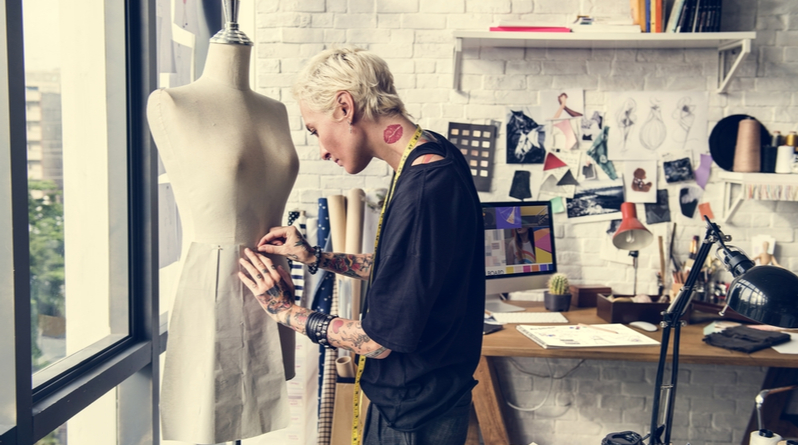What is Fashion Design?
Fashion design is a form of art dedicated to the creation of clothing and other lifestyle accessories. Modern fashion design is divided into two basic categories: haute couture and ready-to-wear.
A fashion designer takes part in just about every aspect of bringing fashion to the public. Fashion Designers sketch designs of clothing and accessories, and assist with the production of clothing, shoes, and accessories, identify trends, and selects styles, fabrics, colours, prints, and trims for a collection.
What 3rd level courses are available?
Universities and colleges in Ireland are offering Fashion Design courses in the following subject areas:
- Introduction to Fashion Design – An introduction to Fashion Design, pattern drafting, and professional garment production.
- Fashion Design – An introduction to Fashion, gain the technical skills in embroidery, garment construction, and pattern drafting.
- Fashion Design Advanced – This course equips learners with the advanced creative skills of theme and concept development through drawn research and investigation. Learners develop the skills required to design and produce their fashion collections.
- Fashion Design HND – Gain the knowledge necessary to further pursue a career in Fashion & Textile Design.
- BA (Hons) In Fashion Design – Learn the technical, design, and business skills needed to transition from student to world-class fashion professional.
- Fashion Design: Dressmaking – This program is suitable for individuals who wish to develop their skills in dressmaking to make and alter their clothes.
- Design Fashion & Textiles – The study of historical and contemporary practice in embroidery with a range of hand and machine stitch techniques, ways of manipulating fabric, and the use of alternative materials as surfaces on which to stitch
Studying Fashion Design in college
Many Fashion Design courses take place over 1 year to 4 years depending on the course and modules selected. There are also part-time courses and night courses available so you can be sure to fit in your studies no matter what your schedule is like.
Courses will cover all theory work through lectures, assignments, tutorials, and taught modules. Assessments will take place continuously with written examinations and practical assignments combined to achieve a qualification.
You could also consider work experience or volunteering to help with fashion events. Getting work experience is vital and experience of any kind in a design studio will help you develop your skills and build up a network of contacts within the industry. Experience in retail can be useful too. Contact fashion houses, designers, departments, and other retail stores and supermarket fashion labels to ask for work experience, and look for opportunities on the websites of fashion companies. Work Experience will not only allow you to obtain a deeper knowledge and understanding of the industry, but it will also give you a chance to do some essential networking with other industry professionals and gain valuable contacts for the future.
Employers will expect to see a portfolio that demonstrates your ability to design and produce garments and accessories.
Career options
After completing a course in Fashion Design you will be able to get started in a career that uses specific knowledge of the Fashion Industry and trends.
Working hours are usually full-time, Monday to Friday. You should expect to work some evenings and extra hours to meet project deadlines from time to time.
Your work environment will vary depending on the company you work for and you could be in a purpose-built office or a small design studio. Freelance designers may work from home or in a rented studio.
With the increase in online retailing, setting up in business or being self-employed is becoming more common, even straight after graduation. Extensive market research and business acumen are critical for any fashion business to succeed.
There are opportunities to travel to meet suppliers, research new trends, and attend trade and fashion shows, either locally or abroad. Self-development is important throughout your career, and you’ll need to take responsibility for keeping your skills and knowledge up to date.
Related jobs include:
- Fashion designer
- Retail buyer
- Retail manager
- Retail merchandiser
- Stylist
- Textile designer
- Visual merchandiser
- Clothing/textile technologist
- Event manager
- Jewelry designer
- Magazine journalist
- Make-up artist
- Public relations officer
- Talent agent
Further study
After completing a course in Fashion Design you may choose to pursue further study in a specialist field to increase your knowledge base and skillset. Postgraduate study can also be used as a means to change career focus or to gain professional qualifications required to practice in certain career areas such as retail buying, photography, fashion styling, or journalism.
FAQ
Are there different types of a fashion designer?
The main areas of work for fashion designers are:
- High street fashion – this is where the majority of designers work and where garments are mass manufactured. It is a commercial, highly media-led area to work in.
- Ready-to-wear – established designers create ready-to-wear collections, produced in relatively small numbers.
- Haute couture – requires large amounts of time spent on the production of one-off garments for the catwalk. Designs usually endorse the brand and create a ‘look’.
What are the Principles of Fashion Designing?
The principles of fashion design must be properly applied and executed in terms of:
· Proportion
· Balance
· Rhythm
· Radiation
· Gradation
· Emphasis
· Contrast
· Harmony
· Unity
· Repetition
· Scale
Where can I study Fashion Design?
Explore your options here
Did You Know?
· There are 40 Fashion Weeks and 100 official events. The five most prominent Fashion Weeks are held in the fashion capitals of the world: Milan, New York, Berlin, London, and Paris. New York starts off the international circuit with its Mercedes Benz Fashion Week.
· The first official Fashion Week started in 1943 in New York. Its main purpose was to distract the attention away from French fashion during World War II and kickstart the way for American designers.
· Sneakers came to us thanks to Keds, the first company to create this type of shoe, in 1917. Converse produced their first pair of sneakers later that year.
· Marc Jacobs, strange as it seems, is the Creative Director of Louis Vuitton, a position he has had for 18 years.
· The T-shirt is one of the most popular items of clothing in the world and around two billion of them are sold every single year.












Comments